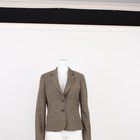Does anyone have any insight about the contents of this
stackoverflow post:
https://stackoverflow.com/questions/65402617/tensorflow-automl-model-in-react
Getting a little desperate.
submitted by /u/eagletongue
[visit reddit]
[comments]
Does anyone have any insight about the contents of this
stackoverflow post:
https://stackoverflow.com/questions/65402617/tensorflow-automl-model-in-react
Getting a little desperate.
submitted by /u/eagletongue
[visit reddit]
[comments]

Object detection is a computer vision task that has recently
been influenced by all of the progress made in ML.
Now with tools like TensorFlow Object Detection API, you can
create reliable models quickly and fairly easily.
If you’re unfamiliar, TensorFlow Object Detection API: –
supports TensorFlow 2, – lets you employ state of the art model
architectures for object detection, – gives you a simple way to
configure models.
Tutorial shows everything from installation and setup, all the
way to model training.
submitted by /u/kk_ai
[visit reddit]
[comments]
I’m building an image classifier. I happen to have a small
dataset of ideal data. Can I train a model using this idealised
data, and somehow use it as a base for further training?
I’ve read through the docs; they all use ImageNet or
tensorflow-hub datasets. I can’t seem to find an example of using
your own data.
submitted by /u/BananaCharmer
[visit reddit]
[comments]
Say you’re classifying the flowers dataset. Some images aren’t
as good as others. Would duplicating the images that are good
examples of a certain type help propagate the desired features in
the network?
E.g. if I duplicate a close-up of a certain type flower head
within the dataset (say a rose within /roses), would it make the
network more bias towards the duplicates?
I have a handful of ideal examples, and thousands of very
variable examples. I’m unsure what’s the best strategy to be more
biased towards the good examples in my data..
submitted by /u/BananaCharmer
[visit reddit]
[comments]
I am currently studying Industrial Engineering, but I’ve been
learning DL and ML on my own. My goal is to obtain a job related
with ML or AI. I don’t come from a traditional Computer Science
background, do you think this certificate will add value to my
CV?
submitted by /u/man_you_trust
[visit reddit]
[comments]

 |
I am delighted to share the TensorFlow JS variants for the The Project repo – https://github.com/Rishit-dagli/MIRNet-TFJS Please consider giving it a star if you like it. More details in submitted by /u/Rishit-dagli |
submitted by /u/maifee
[visit reddit]
[comments]
Hey, this is a question I had that I answered myself after some
research. I can’t find a flair more applicable than ‘Question’ so I
will just answer it myself haha.
I was trying to use tf.keras.preprocessing.text.Tokenizer to
train a model for a language task. I wanted my model to include
certain punctuation in it’s output, like exclamation points and
commas and whatnot, and I wasn’t sure how to do this.
I figured that since the default value for filters in the
Tokenizer constructor is:
filters='!"#$%&()*+,-./:;<=>?@[\]^_`{|}~tn'
then I would just have to remove the punctuation that I want to
be recognized. I then spent a few hours training my model.
DON’T DO THIS. It will not treat the
punctuation as separate tokens, but rather your vocabulary will be
filled with examples such as ‘man’ vs ‘man.’ vs ‘man,’, etc. These
will all be separate tokens.
Instead, you should preprocess all of your sentences to include
spaces between any punctuation that you want. This is how I did
it:
def separate_punctuation(s, filters=',.()?'): new_s = '' for char in s: if char in filters: new_s += ' ' + char + ' ' else: new_s += char return new_s.strip()
This way ‘Hello neighbor, how are you?’ will become ‘Hello
neighbor , how are you ?’. Thus, all punctuation will only take up
one element of your vocabulary and your model will generalize much,
much better.
Hope this saves someone else’s time.
submitted by /u/LivingPornFree
[visit reddit]
[comments]

 |
Hi there! Looking for a way of manipulating something like this: To something like this: There are a decent number of variations on this, e.g. more or I’ve got some basic experience with TensorFlow and Keras, having I have a few questions:
I’ve done a bit of research though haven’t had much luck, but Any and all help would be greatly appreciated! submitted by /u/ljackmanl |
I was trying to make a prediction from a loaded tensorflow
model. Though I’m not sure if it’s correct how I previously saved
it, specifically I have doubts about code inside serving_input_fn()
function (MAX_SEQ_LENGTH=128):
def serving_input_fn(): feature_spec = { "input_ids" : tf.FixedLenFeature([MAX_SEQ_LENGTH], tf.int64), "input_mask" : tf.FixedLenFeature([MAX_SEQ_LENGTH], tf.int64), "segment_ids" : tf.FixedLenFeature([MAX_SEQ_LENGTH], tf.int64), "label_ids" : tf.FixedLenFeature([], tf.int64) } serialized_tf_example = tf.placeholder(dtype=tf.string,shape=[None],name='input_example_tensor') receiver_tensors = {'example': serialized_tf_example} features = tf.parse_example(serialized_tf_example, feature_spec) return tf.estimator.export.ServingInputReceiver(features, receiver_tensors) estimator.export_saved_model('gs://bucket/trained_model, serving_input_receiver_fn=serving_input_fn)
When I try to predict from loaded model:
from tensorflow.contrib import predictor predict_fn = predictor.from_saved_model(LOAD_PATH) input_features_test = convert_examples_to_features( test_examples,label_list, MAX_SEQ_LENGTH, tokenizer) predictions = predict_fn({'example':input_features_test[0]})
it returns this error:
ValueError: Cannot feed value of shape () for Tensor
‘input_example_tensor:0’, which has shape ‘(?,)’
How should I change serving_input_fn() method?
If you want to reproduce it: github_repo (you
should download variables from
here and put it in trained_model/1608370941/ folder)
This is the tutorial I followed to fine tune BERT model on
google cloud TPU.
submitted by /u/spaceape__
[visit reddit]
[comments]